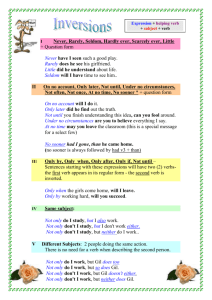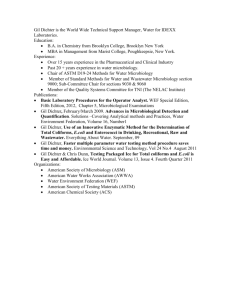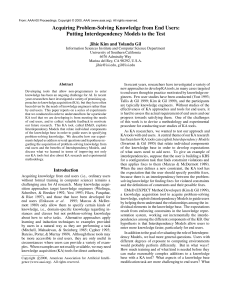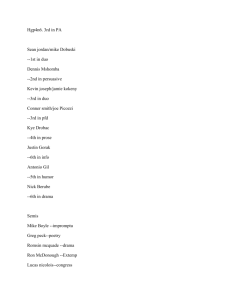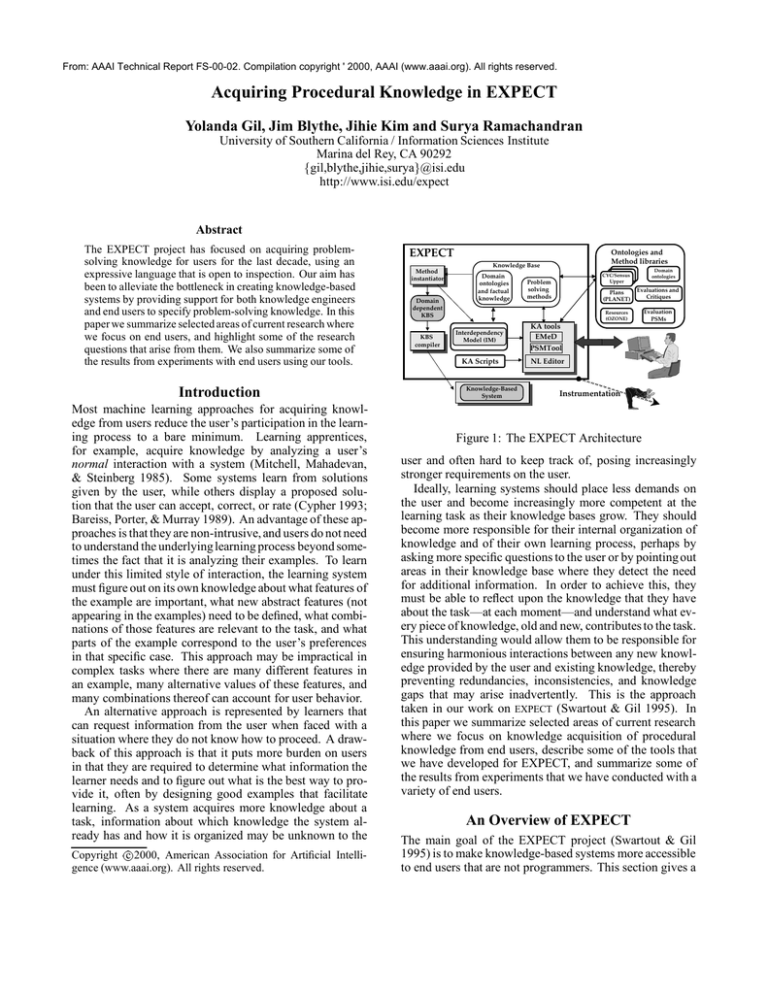
From: AAAI Technical Report FS-00-02. Compilation copyright ' 2000, AAAI (www.aaai.org). All rights reserved.
Acquiring Procedural Knowledge in EXPECT
Yolanda Gil, Jim Blythe, Jihie Kim and Surya Ramachandran
University of Southern California / Information Sciences Institute
Marina del Rey, CA 90292
fgil,blythe,jihie,suryag@isi.edu
http://www.isi.edu/expect
Abstract
The EXPECT project has focused on acquiring problemsolving knowledge for users for the last decade, using an
expressive language that is open to inspection. Our aim has
been to alleviate the bottleneck in creating knowledge-based
systems by providing support for both knowledge engineers
and end users to specify problem-solving knowledge. In this
paper we summarize selected areas of current research where
we focus on end users, and highlight some of the research
questions that arise from them. We also summarize some of
the results from experiments with end users using our tools.
Introduction
Most machine learning approaches for acquiring knowledge from users reduce the user’s participation in the learning process to a bare minimum. Learning apprentices,
for example, acquire knowledge by analyzing a user’s
normal interaction with a system (Mitchell, Mahadevan,
& Steinberg 1985). Some systems learn from solutions
given by the user, while others display a proposed solution that the user can accept, correct, or rate (Cypher 1993;
Bareiss, Porter, & Murray 1989). An advantage of these approaches is that they are non-intrusive, and users do not need
to understand the underlying learning process beyond sometimes the fact that it is analyzing their examples. To learn
under this limited style of interaction, the learning system
must figure out on its own knowledge about what features of
the example are important, what new abstract features (not
appearing in the examples) need to be defined, what combinations of those features are relevant to the task, and what
parts of the example correspond to the user’s preferences
in that specific case. This approach may be impractical in
complex tasks where there are many different features in
an example, many alternative values of these features, and
many combinations thereof can account for user behavior.
An alternative approach is represented by learners that
can request information from the user when faced with a
situation where they do not know how to proceed. A drawback of this approach is that it puts more burden on users
in that they are required to determine what information the
learner needs and to figure out what is the best way to provide it, often by designing good examples that facilitate
learning. As a system acquires more knowledge about a
task, information about which knowledge the system already has and how it is organized may be unknown to the
Copyright c 2000, American Association for Artificial Intelligence (www.aaai.org). All rights reserved.
EXPECT
Method
instantiator
Domain
dependent
KBS
KBS
compiler
Ontologies and
Method libraries
Knowledge Base
Domain
ontologies
and factual
knowledge
Domain
ontologies
CYC/Sensus
Upper
Problem
solving
methods
Plans
(PLANET)
Evaluations and
Critiques
Resources
(OZONE)
Interdependency
Model (IM)
Evaluation
PSMs
KA tools
EMeD
PSMTool
KA Scripts
Knowledge-Based
System
NL Editor
Instrumentation
Figure 1: The EXPECT Architecture
user and often hard to keep track of, posing increasingly
stronger requirements on the user.
Ideally, learning systems should place less demands on
the user and become increasingly more competent at the
learning task as their knowledge bases grow. They should
become more responsible for their internal organization of
knowledge and of their own learning process, perhaps by
asking more specific questions to the user or by pointing out
areas in their knowledge base where they detect the need
for additional information. In order to achieve this, they
must be able to reflect upon the knowledge that they have
about the task—at each moment—and understand what every piece of knowledge, old and new, contributes to the task.
This understanding would allow them to be responsible for
ensuring harmonious interactions between any new knowledge provided by the user and existing knowledge, thereby
preventing redundancies, inconsistencies, and knowledge
gaps that may arise inadvertently. This is the approach
taken in our work on EXPECT (Swartout & Gil 1995). In
this paper we summarize selected areas of current research
where we focus on knowledge acquisition of procedural
knowledge from end users, describe some of the tools that
we have developed for EXPECT, and summarize some of
the results from experiments that we have conducted with a
variety of end users.
An Overview of EXPECT
The main goal of the EXPECT project (Swartout & Gil
1995) is to make knowledge-based systems more accessible
to end users that are not programmers. This section gives a
(define-method M1
(documentation “In order to estimate the time that it takes to narrow
a gap with a bulldozer, combine the total dirt volume to be moved
and the standard earthmoving rate.”)
(capability (estimate (obj (?t is (spec-of time)))
(for (?s is (inst-of narrow-gap)))))
(result-type (inst-of number))
(body (divide (obj (find (obj (spec-of dirt-volume))
(for ?s)))
(by (find (obj (spec-of standard-bulldozing-rate))
(for ?s))))))
(define-method M2
(documentation “The amount of dirt that needs to be moved in any
workaround step that involves moving dirt (such as narrowing a gap
with a bulldozer) is the value of the role earth-volume for that step.”)
(capability (find (obj (?v is (spec-of dirt-volume)))
(for (?s is (inst-of move-earth)))))
(result-type (inst-of number))
(body (earth-volume ?s)))
(define-method M3
(documentation “The standard bulldozing rate for a workaround step
that involves earthmoving is the combined bulldozing rate of the dozers specified as dozer-of of the step.”)
(capability (find (obj (?r is (spec-of standard-bulldozing-rate)))
(for (?s is (inst-of bulldoze-region)))))
(result-type (inst-of number))
(body (find (obj (spec-of standard-bulldozing-rate))
(of (dozer-of ?s))))
Figure 2: Example EXPECT Methods.
brief overview of the architecture, more details can be found
in (Swartout & Gil 1995; Gil & Melz 1996; Gil 1994).
An overview of the architecture is shown in Figure 1. EXPECT provides a highly declarative framework for building
knowledge-based systems. Ontologies are used to represent
domain objects as well as general theories about domainindependent classes, while task knowledge is represented
as problem solving methods. Ontologies are represented
in LOOM (MacGregor 1991), a knowledge representation
system based on description logic. Every concept or class
can have a definition that intensionally describes the set
of objects that belong to that class. Concept descriptions
can include type and number restrictions of the fillers for
relations to other concepts. Relations can also have definitions. LOOM uses the definitions to produce a subsumption hierarchy that organizes all the concepts according to
their class/subclass relationship. Problem-solving knowledge is represented in a procedural-style language that is
tightly integrated with the LOOM representations (Swartout
& Gil 1995). Subgoals that arise during problem solving
are solved by methods. Each method description specifies:
1) the goal that the method can achieve, 2) the type of result
that the method returns, and 3) the method body containing
the procedure that must be followed in order to achieve the
method’s goal. The language includes expressive parameter
typing, conditional statements, and some forms of iteration.
Some problem solving knowledge is domain-independent,
such as general principles of plan evaluation described in
(Blythe & Gil 2000). Problem solving knowledge can also
be domain specific. Figure 2 shows some examples of
such methods from a system to assess enemy workarounds
to target damage. Given a bridge as a target, a possible
workaround if the river bed is dry is to use bulldozers to
narrow the gap. EXPECT can import external ontologies
and knowledge bases.
Our research in knowledge acquisition has concentrated
on the acquisition of problem-solving knowledge. We have
focused on several central issues that users of a knowledge
acquisition tool are concerned with:
How do users know that they are adding the right things?
Users need to know that they are providing knowledge
that is useful to the system and whether they have given
the system enough knowledge to do something on its
own. Our approach is to use Interdependency Models that capture how the individual pieces of knowledge
provided work together to reason about the task (Kim
& Gil 1999). These Interdependency Models are derived
automatically by the system, and are used to detect inconsistencies and missing knowledge that turn into follow-up
questions to the user. Users are often not sure whether
they are on the right track even if they have been making
progress, so we have found that it is very useful to show
the user some aspects of this Interdependency Model (for
example, showing the substeps involved in doing a task)
and how it changes over time.
How do users know where to start and what to do next?
Intelligent systems use knowledge to perform tasks for
the user. If the acquisition tool has a model of those
tasks, then it can reason about what kinds of knowledge
it needs to acquire from the user. We have developed
acquisition tools that reason about general task models and other kinds of pre-existing knowledge (such as
domain-specific knowledge that is initially included in
the system’s knowledge base) in order to guide users
to provide the knowledge that is relevant to those tasks
(Blythe & Gil 2000). Our work has concentrated on plan
evaluation and assessment tasks, but could be used with
other task models. We have also developed a framework
to guide users through typical sequences of changes or
Knowledge Acquisition Scripts (KA Scripts) (Tallis &
Gil, 1999). As the user interacts with a KA Script and
enters knowledge step by step, additional KA Scripts may
be activated that contain follow-up questions about that
new knowledge. We have develop a library of generalpurpose KA Scripts (Tallis & Gil, 1999), as well as with
scripts customized to the general task models mentioned
above (Blythe & Gil 2000).
Users do not know formal languages.
We have developed English-based editors that allow
users to modify English paraphrases of the internal, more
formal representations (Blythe & Ramachandran 1999).
Users can only select the portions of the paraphrase that
correspond to a valid expression in the internal language,
and pick from a menu of suggested possible replacements
for that portion. This approach enables the system to communicate with the user in English while circumventing
Errors in
interdependencies
Point out missing
knowledge
Proposed initial
sketch
of new method
Structured
editor
Figure 3: A screenshot from the EMeD Interface.
the challenges of full natural language processing.
EXPECT has several acquisition interfaces that exploit
each of these approaches, and are implemented in a clientserver architecture within the overall system. The rest of
the paper describes some of these tools in more detail.
Exploiting Interdependency Models to
acquire procedural knowledge
A theme of our KA research has been how KA tools can
exploit Interdependency Models (Swartout & Gil 1995) that
relate individual components of the knowledge base in order
to develop expectations of what users need to add next.
EMeD (EXPECT Method Developer) (Kim & Gil 1999;
2000), a knowledge acquisition tool to acquire problemsolving knowledge, exploits the Interdependency Models
to guide users by helping them understand the relationships
among the individual elements in the knowledge base. Our
hypothesis is that Interdependency Models allow users to
enter more knowledge faster, particularly for end users.
We analyzed the user tasks during knowledge base development and found several areas where an acquisition
tool could help: (1) pointing out missing pieces at a given
time; (2) predicting what pieces are related and how; (3) detecting inconsistencies among the definitions of the various
elements in the knowledge base. We then expanded Interdependency Models, developing a set of techniques and
principles that could guide users in both knowledge base
creation and modification. The expectations result from enforcing constraints in the knowledge representation system,
working out incrementally the interdependencies among the
different components of the KB. As the user defines new KB
elements (e.g., new problem-solving knowledge), the KA
tool can form increasingly more frequent and more reliable
Figure 4: A screenshot from the PSMTool interface.
expectations. Figure 3 shows a screenshot from the EMeD
interface.
When users define new procedural knowledge (problemsolving methods), EMeD first finds the interdependencies
and inconsistencies within that element, such as if any undefined variable is used in the body of the procedure. If there
are any errors within a definition, the Local-Error Detector
displays the errors and it also highlights the incorrect definitions in red so that the user can be alerted promptly. The
Global-Error Detector analyzes the knowledge base further
and detects more subtle errors that occur in the context of
problem solving. By keeping the interdependencies among
the problem-solving methods and factual knowledge, and
analyzing interdependencies between each method and its
sub-method, the Method Sub-method Analyzer in EMeD
can detect missing links and can find undefined problem-
solving methods that need to be added. EMeD highlights
those missing parts and proposes an initial version of the
new methods. When the system is missing the knowledge,
the Method Proposer in EMeD notifies the user and displays the ones needed to be defined. It can also construct
an initial sketch of the new method to be defined. Users
can search for existing methods that can achieve a given
kind of capability using the Method-Capability Hierarchy,
a hierarchy of method capabilities based on subsumption
relations of their goal names and their parameters. Finally,
EMeD can propose how the methods can be put together.
By using the Method Sub-method Analyzer for analyzing
the interdependencies among the KB elements, it can detect
still unused problem-solving methods and propose how they
may be potentially used in the system.
Our evaluations show an average over thirty percent time
savings for different user groups, including end users with
no formal computer science training. The results also show
that KA tool that exploits Interdependency Models helped
end users enter more knowledge.
Exploiting background knowledge about tasks
End users who are not programmers are often unable
to modify procedural knowledge directly, even with
interdependency-based tools. Often they are unsure where
to even begin when specifying how to perform some task
and understanding a language for procedural information is
also an obstacle. We address these issues by guiding the
user through the process of adding problem-solving knowledge using background knowledge about a generic task type
such as a problem-solving method library. We also use an
English-based method editor so that users can modify task
knowledge without having to see and understand the EXPECT programming language. Using the combination of
these two approaches, we have been able to acquire procedural knowledge from end users who were not programmers
that was directly executable (Blythe & Gil 2000).
We use background knowledge about a task area in several different ways to guide users adding new knowledge in
that area. One way it is used is to identify which of a set of
generic procedures might be appropriate to specialize for a
given task. In this case, a tool can help a user to get started
with a question-answer dialog that concentrates on features
of the task to be performed rather than on programming
constructs. Then it can recommend a generic KBS from a
library that goes some of the way to performing the task
that the user wants to define. Here the required knowledge
includes a set of generic procedures that are useful within
a domain, information about appropriateness conditions for
each one, about the information they need and about the
relative strengths and weaknesses of alternative procedures.
This information is in a form that can be operationalized as
easily understandable questions for the user.
We also use background knowledge about a procedural
task domain to help the user specialize a procedure once it
has been selected. Some parts of a procedure should usually
not be changed by a naive user since they define the way
the generic task is performed. (These are often at the upper
Figure 5: A Screenshot from the English-based editor.
levels of a procedure definition.) Other parts are designed
to be changed for a specific task, and are often represented
as stubs. Knowledge about which parts of a task description
can easily be changed and which should stay fixed can allow
a tool to guide the user in modifying the procedure. One
can also provide knowledge about the way that certain parts
of the procedure are expected to be changed.
Notice that this is complementary to the Interdependency
Model described in the last section. As a user modifies a
generic task, a tool such as EMeD can help the user with
information about missing pieces of the modified knowledge and about other parts that may need to be changed for
consistency. Here, the background knowledge has solved
the problem of how to start defining a task.
We built a problem-solving method library for plan evaluation and a KA tool called PSMTool that uses background
knowledge in the ways we have described to guide users
building new KBs for plan evaluation tasks (Blythe & Gil
2000). Figure 4 shows a screenshot from the PSMTool interface. In experiments in two different domains, end users
were able to add new procedural knowledge for evaluating
plans that could be directly executed. We found that users
could complete on average 60% more tasks when using a
full version of PSMTool than when using an ablated version
that did not use background knowledge. They completed
tasks on average 3 times as quickly with the full version.
Editing methods with an English-based editor
We also use an English-language based editor that presents
problem-solving methods in an English paraphrase. The editor allows the user to select parts of the method as phrases of
English and automatically creates a set of probable new fragments that the part can be changed to. These are presented
for the user to select from, also in an English paraphrase.
Thus users to modify task knowledge without having to see
and understand the EXPECT programming language. Figure 5 shows a screenshot from this editor. The power of this
editor comes from the combination of hiding the underlying
language and providing a browsable list of useful program
elements and can be used to specify arbitrary procedural
knowledge (Blythe & Ramachandran 1999).
Evaluations with End Users
We wanted to put our KA tools to the test and understand
how accessible they are to end users. Could end users use
current KA tools to modify the problem-solving knowledge
of a knowledge-based system? How much training do they
need to start using such KA tools? Would they be able to
understand and use a formal language? We performed several suites of experiments with different kinds of users that
had no background in AI and programming. The study presented here shows results from testing Army officers using
our KA tools to extend a Course of Action critiquer, and
was part of the Knowledge Acquisition Critical Component Experiment that was conducted as part of the DARPA
High Performance Knowledge Bases program (Cohen et
al. 1998). More details on these and other studies acn
be found in (Kim & Gil 2000; 2000; Blythe & Gil 2000;
Tallis & Gil, 1999).
With EMeD, we spent 8 hours (two half-day sessions)
for training. Users spent roughly half of that time learning
EXPECT’s language and how to put the procedural knowledge together. The rest of the time was spent learning about
the KA tool and its ablated version. We believe that this
time can be reduced by improving the tool’s interface and
adding on-line help. More training may be needed if users
are expected to make much more complex changes to the
knowledge base. At the same time, if they did not need to
be trained on how to use an ablated version of the tool they
would not need to learn as many details as our subjects did.
Our subjects got used to the language and could quickly
formulate new procedural knowledge correctly. They did
not seem to have a problem using some of the complex aspects of our language, such as the control structures (e.g.,
if-then-else statement) and variables. It took several examples to learn to express procedural knowledge into methods
and sub-methods and to solve problems. EMeD helps this
process by automatically constructing sub-method sketches
and showing the interdependencies among the methods. Retrieving role values through composite relations was also
hard. Providing a better way to visualize how to find this
kind of information would be very useful.
In one experiment with PSMTool, users worked with the
tool after having taken the training for EMeD, with an extra
45 minutes of training on PSMTool. In a second experiment
users only saw PSMTool and received one hour of training
that showed the tool and how to put procedural knowledge
together using the English-based editor. These users were
able to effectively use the tool to define new tasks, indicating
that procedural knowledge can be directly specified by users
with very little training. Again, the more complex the task
knowledge, the more training may be required.
For each tool we created an ablated version that lacks Interdependency Models in the case of EMeD or background
knowledge in the case of PSMTool. The differences in the
number of tasks that users could complete are shown in Fig-
14
12
10
8
with EMeD
6
ablated version
4
2
0
easier
task 1
easier
task 2
more
complex
task 1
more
complex
task 2
All
(a) Number of tasks completed by users for EMeD
35
30
25
20
with PSMTool
ablated versio
15
10
5
0
easier
task 1
easier
task 2
more
more
complex complex
task 1
task 2
All
(b) Number of tasks completed by users for PSMTool
Figure 6: Number of tasks completed by users for EMeD
(a) and PSMTool (b), with the full and ablated versions of
the tools.
ure 6, both by task category and overall. Averaged across
both tools, users could complete roughly twice as many
tasks with the full versions as with the ablated versions.
Discussion
One important issue is to identify what aspects of a knowledge base modification task are more challenging to end
users when using KA tools. Some subjects using EMeD
had difficulties in starting the KA tasks, when it does not
point to a particular element of the KB to start with. Although they could use the search capability or look up related methods in the tool, this was more difficult for them
than the cases when the elements or problems to be resolved
were already present in the KB and could be highlighted by
the tool. PSMTool is able to provide more help for starting
a task, but only in cases where pre-specified generic task
knowledge can be appropriately modified.
Typically, a KA task involves more than one step, and
sometimes subjects are not sure if they are on the right track
even if they have been making progress. Here PSMTool is
helpful because it keeps track of what users are doing in the
context of the overall task and lets the user visualize their
progress. KA tools that help with this in a broader range of
situations would be very helpful.
Another important issue is whether KA tools need to be
different for users with different degrees of background in
computer science. We did not know whether end users
would need a completely different interface from knowledge engineers. It seems that a few improvements to the
presentation in order to make the tool easier to use was all
Pointing out where to start
English-based paraphrasing
of formal knowledge
User can see progress
Figure 7: Screenshot from new EXPECT Interface
they needed. The editors that help the users avoid syntax
problems were important. In interviews we found that end
users consistently preferred a version that used an English
paraphrase, but we have not tested whether this leads to
improved performance.
On the other hand, we were surprised that end users found
some of the features useful when we had expected that they
would cause confusion. For example, a feature we thought
would be distracting is organizing procedural knowledge
into a hierarchy, but it seemed more useful for the end users
than for knowledge engineers.
Although EMeD and PSMTool are proactive in providing
guidance, we believe that some users would perform better
if we used better visual cues or pop-up windows to show the
guidance. As the users are more removed from the details,
the KA tool needs to do a better job at emphasizing and
making them aware of what is important.
We are currently integrating the tools described here into
a unified acquisition interface. Figure 7 shows a screenshot
of a preliminary version of the new integrated acquisition
interface for EXPECT. The complementary capabilities of
the different approaches will help us create a more comprehensive environment for acquiring procedural knowledge.
We are also beginning research into verification and validation techniques that will extend the scope of our existing
approaches.
Acknowledgments
We gratefully acknowledge the support of DARPA with
grant F30602-97-1-0195as part of the DARPA High Performance Knowledge Bases program, and with grant F3060200-2-0513 as part of the DARPA Active Templates program.
References
Bareiss, R.; Porter, B.; and Murray, K. 1989. Supporting
start-to-finish development of knowledge bases. Machine
Learning 4:259–283.
Blythe, J., and Gil, Y. 2000. Extending the role-limiting approach: Supporting end-users to acquire problem-solving
knowledge. In Proc. ECAI 2000 workshop on Applications
of Ontologies and Problem-Solving Methods.
Blythe, J., and Ramachandran, S. 1999. Knowledge acquisition using and english-based method editor. In Proc.
Twelfth Knowledge Acquisition for Knowledge-Based Systems Workshop.
Cohen, P.; Schrag, R.; Jones, E.; Pease, A.; Lin, A.; Starr,
B.; Gunning, D.; and Burke, M. 1998. The DARPA
High Performance Knowledge Bases Project. AI Magazine
19(4).
Gil, Y. 1994. Knowledge refinement in a reflective architecture. In Proceedings of the Twelfth National Conference
on Artificial Intelligence.
Gil, Y., and Melz, E. 1996. Explicit representations of
problem-solving strategies to support knowledge acquisition. In Proceedings of the Thirteenth National Conference
on Artificial Intelligence.
Cypher, A. 1993. Watch what I do: Programming by
demonstration. MIT Press.
Kim, J., and Gil, Y. 1999. Deriving expectations to guide
knowledge-base creation. In Proc. Sixteenth National Conference on Artificial Intelligence. AAAI Press.
Kim, J., and Gil, Y. 2000. User studies of an
interdependency-based interface for acquiring problemsolving knowledge. In Proceedings of the Intelligent User
Interface Conference, 165–168.
Kim, J., and Gil, Y. 2000. Acquiring problem-solving
knowledge from end users: Putting interdependency models to the test. In Proc. Seventeenth National Conference
on Artificial Intelligence. AAAI Press.
R. MacGregor. The evolving technology of classificationbased knowledge representation systems. In J. Sowa, editor, Principles of Semantic Networks: Explorations in
the Representation of Knowledge. Morgan Kaufmann, San
Mateo, CA, 1991.
Mitchell, T.; Mahadevan, S.; and Steinberg, L. 1985.
LEAP: A learning apprentice for VLSI design. In Proceedings of the 1985 International Joint Conference on
Artificial Intelligence.
Swartout, W. R., and Gil, Y. 1995. Expect: Explicit representations for flexible acquisition. In Proc. Ninth Knowledge Acquisition for Knowledge-Based Systems Workshop.
Tallis, M. and Gil, Y. 1999. Designing scripts to guide users
in modifying knowledge-based systems. In Proceedings
of the Sixteenth National Conference on Artificial Intelligence, Orlando, FL.

